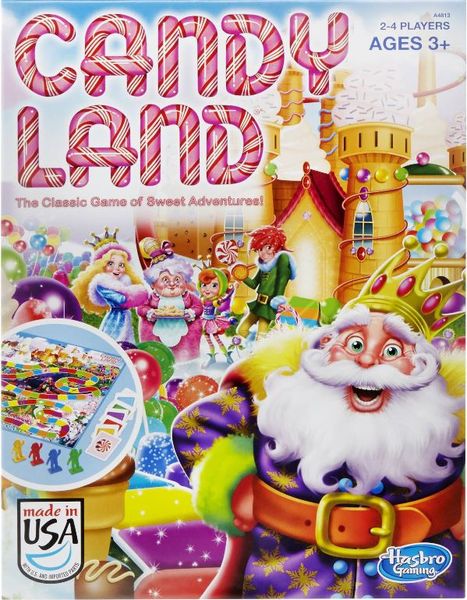Candy Land (1949) Board Game
Candy Land is a classic board game that was first released in in 1949. It was designed by Eleanor Abbott and published by Hasbro. The game is aimed at children aged 3 and up, making it a popular choice for families looking for a fun and simple game to play together.
Game Components of Candy Land
How To Setup Candy Land
To set up the game, shuffle the card deck and place it within easy reach of all players. Each player selects a marker and places it at the “Start” position. The youngest player goes first, drawing the top card from the deck and moving their marker to the corresponding colored space on the board. Players follow in turn, drawing cards and moving accordingly.
Gameplay Mechanics and Game Objective
– Drawing colored cards or location cards to determine movement.
– Moving markers to the next space matching the color or location on the card.
– Some cards have two marks of a color, requiring a move to the second-next space of that color.
– Special locations like Molasses Swamp or Cherry Pitfalls can halt or move players backward.
– The first player to reach the final space, traditionally the purple Candy Castle, wins the game.
Player Experience
Playing Candy Land is a straightforward and enjoyable experience, especially for young children. The game introduces basic concepts such as taking turns, following rules, and understanding simple movement instructions. It lacks strategy and player choices, making it purely deterministic, but this simplicity is part of its charm for its target age group.
Pros
Cons
Personal Thoughts on Candy Land
Candy Land is an excellent game for young children, particularly those aged 3 and above. It serves as an introduction to board games, teaching fundamental concepts like turn-taking and rule-following. While it may not offer the complexity and strategy that older players crave, its simplicity and colorful design make it a beloved classic for preschoolers. It’s a great tool for parents and educators to help children develop social and motor skills in a fun and engaging way. However, for those seeking more challenging or strategic gameplay, Candy Land might not be the best fit.
We are supported by our audience. When you purchase through links on our site, we may earn an affiliate commission, at no extra cost for you. Learn more.

